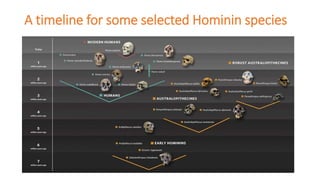Human evolution
- 2. • Human evolution: refers to the evolutionary process leading up to the appearance of modern humans. • The species Homo sapiens is about 200,000 years old, which is very young, considering that life has existed on Earth for at least 3.5 billion years. • Derived from early Homonins (Homonids)
- 3. Human evolution is characterized by a number of morphological, developmental, physiological, and behavioural changes . The most significant of these adaptations are 1. bipedalism (1.9 million years ago), 2. increased brain size, 3. lengthened ontogeny (gestation and infancy), 4. decreased sexual dimorphism.
- 4. Characters that distinguish humans from other apes: Upright posture and bipedal locomotion Larger brains Language capabilities and symbolic thought The manufacture and use of complex tools Shortened jaw Shorter digestive tract
- 6. The Earliest Hominins •The study of human origins is known as palaeoanthropology •Hominins (formerly called hominids) are more closely related to humans than to chimpanzees •Paleoanthropologists have discovered fossils of about 20 species of extinct hominins
- 7. • Hominins originated in Africa about 6–7 million years ago. • Early hominins had a small brain but probably walked upright. • Two common misconceptions about early hominins: • Thinking of them as chimpanzees • Imagining human evolution as a ladder leading directly to Homo sapiens • We are taking a closer look to the Hominins called Australopiths and Homo
- 8. A timeline for some selected Hominin species
- 9. • Australopiths are a paraphyletic assemblage of hominins living between 4 and 2 million years ago. • Some species walked fully erect. • “Robust” australopiths had sturdy skulls and powerful jaws. • “Gracile” australopiths were more slender and had lighter jaws . • Australopiths got their name from the 1924 discovery in South Africa of Australopithicus africanus (“southern ape of Africa”)
- 10. AUSTRALOPITHICUS AFRICANUS • Walked fully upright (Bipedal) • Had humanlike hands and teeth. • Had a brain 1/3 of present humans Mrs Ples” was an Australopithecus africanus that lived more than 2-million years ago in the Cradle of Humankind
- 11. References Lukas6632. (2018) Evolution The Human Story PDF FORMAT read online, ^^ Evolution The Human available from https://www.slideshare.net/lukas6632?utm_campaign=profiletracking&utm_medium=sssite&utm_sour ce=ssslideview Lkocian. (2013) Biology 163 2nd semester review Available from https://www.slideshare.net/lkocian?utm_campaign=profiletracking&utm_medium=sssite&utm_source= ssslideview Mthibe, M. (2013) Unit 6 human evolution a Available from https://www.slideshare.net/cantget?utm_campaign=profiletracking&utm_medium=sssite&utm_source= ssslideview











